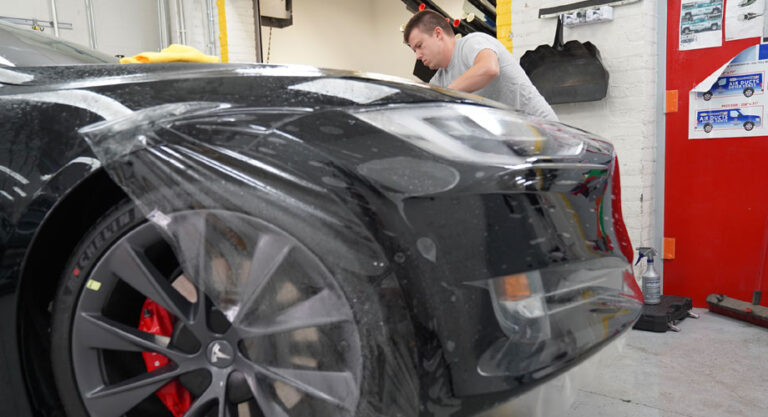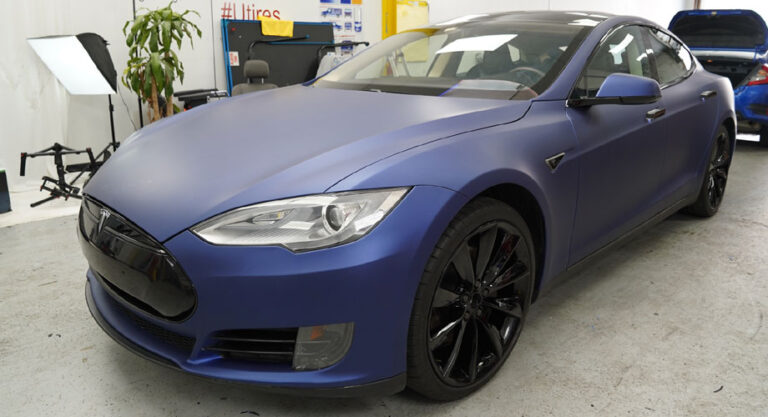

























































































































































































































































































There are many reasons why car tinting is a great idea. It’s stylish and not only that. Window tinting brings tons of practical benefits. It safeguards your health, improves privacy, protects your car’s interior and improves driving comfort. So, this aesthetic upgrade is a decent investment in your car and your well-being. You can find several types of window tinting film on the market – dyed, carbon, metalized and nano ceramic tint. How can you understand their advantages and disadvantages? Let’s compare the two most frequently used options – nano-ceramic tint vs. regular tint.

What is nano ceramic tint?
Nano ceramic window tinting is the top choice among all available options. It’s made of non-metallic ceramic particles, which are integrated into the tinting material. Nano-ceramic technology enhances its effectiveness against infrared radiation and UV rays. Nano ceramic window film is a high-tech solution that will not affect your electronic devices – they will make them work seamlessly even with the tint. And that’s not all. Ceramic window tint provides exceptional clarity – a driver’s view remains uncompromised, but annoying sun glare is reduced. This makes it a fantastic choice for those who want privacy, comfort, and visibility in one package. These characteristics make nano ceramic tint a compelling option for car owners who value performance and durability. But these premium features come at a relatively higher price compared to regular tint.
Nano ceramic tint benefits
- Incredible strength thanks to microscopic ceramic particles in its composition.
- Increased thermal protection. The composition makes ceramic window tints highly resistant to UV and IR radiation.
- It does not affect GPS, GSM and other radio signals since it does not have a metallized layer. Accordingly, electronic devices are less glitchy and more comfortable to use.
- Excellent optical characteristics. Ceramic tint provides immaculate visibility, no visual distortion and blocks glare;
- Longevity. Ceramic tint does not fade and can serve for years without losing its properties.
Shortcomings of ceramic tint
- Higher cost. Ceramic tint is more expensive than traditional tints. It can be a limiting factor for those on a tight budget.
- Installation complexity. Due to its unique composition, ceramic tint needs to be applied by professionals, and the installation process can be more time-consuming.
What is regular tint?
Regular tinting serves two purposes – sun protection and privacy. It is made from polyester or laminate and is often dyed in darker shades. Regular tint works as sunglasses and has a scratch-resistant coating. Regular tint adds a layer of protection against everyday wear and tear, but it remains vulnerable to damage from sharp or hard objects. Gradually, it gets thinner and wears off. And it doesn’t completely block out UV rays – a certain amount still penetrates and raises interior temperatures. Also, regular window tinting is a budget-friendly option. However, its durability may be a concern, and car owners need to re-tint windows quite often. It’s cost-effective at first glance, but the long-term expenses outweigh the initial savings.
Benefits of regular tint
- Price. Regular window tint is the most affordable option available. If you want tinted windows but have a tight budget, regular tint might be a good choice.
- Privacy. Regular tints will ensure more privacy in your car. It comes in all shades and colors. Besides, you can adjust the LVT to your liking.
- Moderate level of UV and IR protection. This option is suitable for those who are not too concerned about protecting from UV rays or infrared light, as regular tint blocks only a small percentage of ultraviolet rays.
Shortcomings of regular tint
- Regular window tint does not last long. It tends to fade and change color faster than other types of window tint. So, even if it does not get damaged, you might need to replace it quite often.
- Regular tints can be easily damaged compared to stronger options like ceramic tints.
- If regular tint contains metal particles, it can mess with your cell phone and Wi-Fi signals.
Nano ceramic tint vs. regular tint – what’s the difference?
Let’s compare the key parameters of both options to see what you can expect after installing ceramic tint and regular tint.
Heat rejection
- Ceramic tint comes with superior heat rejection capabilities, as it can block up to 99% of UV rays. This characteristic allows for a significant reduction of heat transfer.
- Regular tint. Its heat-reduction abilities are comparatively weak. Furthermore, it puts more stress on the windows and can even make it hotter inside your car.
UV protection
- Ceramic tint offers unique UV protection, blocking 99% of UV rays. It allows shielding the car interior, as well as the people inside.
- Regular tint also comes with a degree of UV protection but it is much lower compared to ceramic tint.
Clarity and visibility
- Ceramic tint provided exceptional visibility and improved clarity. It perfectly reduces sun glare and headlights.
- Regular tint. Certain types of regular tints provide effective glare reduction, while others provide very limited or no glare protection at all.
Durability
- Ceramic tint is known for its long-lasting performance. It is resistant to fading and discoloration and will perform its job for years.
- Regular tint may fade and lose its qualities over time.
Price
- Ceramic tint is more expensive than other options available in the market. It is explained by advanced technology.
- Regular tint is the solution that will be fine for a tight budget.
At first glance, it may seem that ceramic window tint is an absolute winner. However, both choices are good. The decision depends on the requirements and expectations of car owners, as well as their budget.
our latest news!
Nano-ceramic tint vs. regular tint – what is the main difference?
The key distinctions are composition and performance. Ceramic tint incorporates ceramic particles, which deliver exceptional heat reduction and UV protection, preserving excellent clarity at the same time. In contrast, regular tint is polyester or laminate-based and relies on a dye layer to offer basic heat reduction and privacy.
Is nano-ceramic tint better than regular tint?
Ceramic tint has several undeniable advantages. It provides better heat reduction, superior UV protection, and maintains high clarity. Ceramic tint is also non-metallic and doesn’t interfere with electronic signals. While regular tint is more budget-friendly, ceramic tint is a better investment thanks to its long-term benefits.
Is nano-ceramic tint darker than regular tint?
The shade of ceramic tint and regular tint can vary depending on the percentage of tint applied. Actually, the darkness of the tint is determined by the Visible Light Transmission (VLT) percentage, which indicates how much light is allowed to pass through the tint. Nano-ceramic tints and regular tints can have various VLT percentages.
Is nano-ceramic window tint worth the extra cost?
Ceramic window tinting comes at a higher price point compared to regular tint, but it offers significant advantages. Nano-ceramic tint blocks 99% of UV rays, reduces sun glare and is very durable. Additionally, it provides a shatter-proof effect in the event of glass breakage.
Nano-ceramic tint vs. regular tint – will they fade?
Nano-ceramic tint is often more resistant to fading compared to regular tint because it contains ceramic particles that are less prone to deterioration from UV exposure. It’s known for its durability and longevity. Regular tint, on the other hand, may fade more quickly due to its dye-based composition, which is more susceptible to UV damage.
Conclusion
Summing up, the choice between ceramic tint and regular tint ultimately depends on your specific needs and preferences. Ceramic tint wins when it comes to heat reduction, UV protection, and visual clarity. It is the top choice for those seeking peak performance and durability. On the other hand, regular tint steps in as the budget-friendly option, offering basic heat reduction, privacy enhancement, and a range of color choices. So, the ultimate decision is based on your priorities, budget, and the benefits you are looking for in your tinting solution. Whichever option you choose, remember that professional installation and diligent maintenance are key to ensuring the longevity and effectiveness of your window tint.






























 Send a message
Send a message Send a message
Send a message